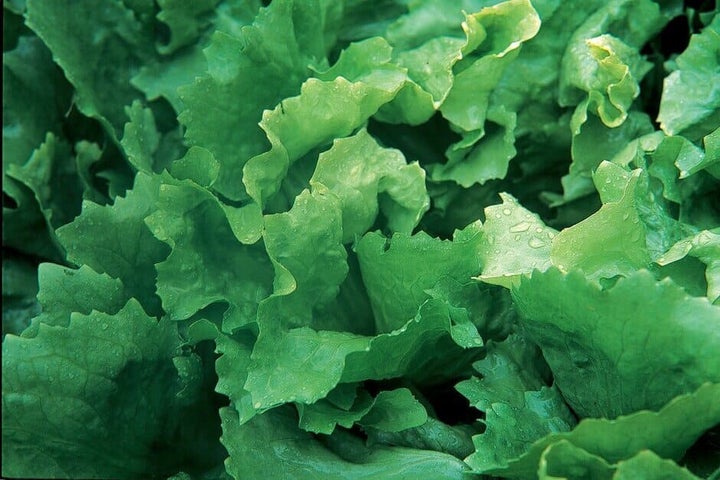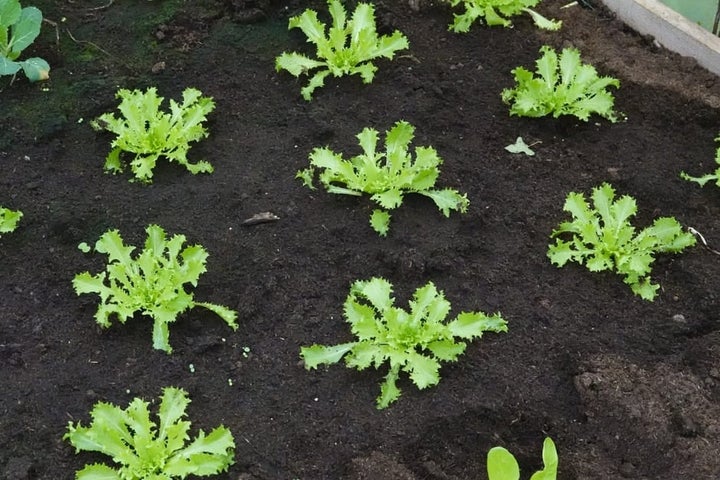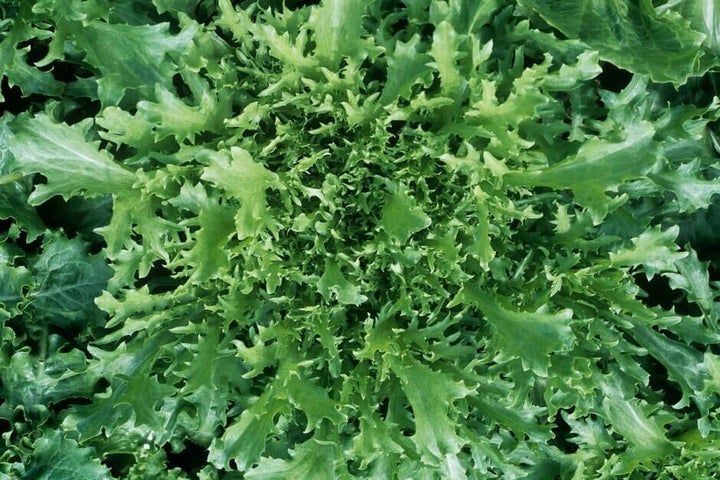Getting Started
Endive is a compact, lettuce-like plant, harvested either as young salad leavesor mature heads. The leaves have a bitter flavour, so are traditionally blanched to make them milder and more tender. They’re ideal for pepping up a mixed salad.

Endive is grown in a similar way to other leafy salad crops such aslettuces and chicory, in the ground or in containers. It is easiest and quickest as a cut-and-come-again crop as plants take up little space and you can start harvesting leaves in as little as a month, usually making two or more pickings before they start to flower and need replacing. Mature heads are slower growing and larger, taking around three months to mature. Sowing seeds little and often can provide you with steady harvests from late spring right through into winter.
Month by Month
Sow
Plant Out
Harvest
Choosing What To Grow
There are two types of endive to choose from:
- Curly or fringed frisée – these form an attractive, loose rosette of thin, frilly leaves, ideal for summer salads. They tend to be more tolerant of hot weather
- Batavian or escarole – these have large, flat, broad leaves of various colours. They are more robust, so very useful for winter harvesting

There are many varieties of each type of endive, in a choice of leaf shapes, making an attractive crop in a veg plot or container. The flavour can vary from relatively mild to quite bitter, so choose varieties to suit your taste. Some are better for growing as a cut-and-come-again crop, others as whole heads. Some are self-blanching, others are resistant to bolting, which is useful for early sowings. Sowing and harvesting times vary depending on the variety, so check details on the seed packet.
When choosing varieties, look in particular for those with an RHS Award of Garden Merit (AGM), which shows they performed well in our growing trials – see our list of AGM fruit and veg (135kB pdf) and our Recommended Varieties below. You can also see many leafy salad crops such as endive growing in the veg plots at the RHS gardens, so do visit to see how they are grown, compare the varieties and pick up useful tips.
What and where to buy
Endive seeds are available in garden centres and from online seed suppliers.
Recommended Varieties

'Pancalieri' AGM
Frisée – a classic variety with finely serrated leaves and a light-coloured heart.


‘Wallone’ AGM
Frisée – large, vigorous plants with finely cut leaves. Good for cut-and-come-again cropping.
Preparing The Ground
Endive grows best in a sunny location, although it will also tolerate partial shade in summer. Most soil types are suitable, as long as conditions don’t get very dry or stay .
Prepare the ground by digging-in plenty of garden compost or well-rotted manure to aid moisture retention. Ideally do this a few weeks before sowing or planting to allow the soil to settle. Alternatively, if you're practising no-dig, the soil ahead of sowing or planting directly into the mulch.
Sowing
Endive is easy to grow from seed, either indoors or outdoors once temperatures are warm enough.
When to sow
Endive seeds need a soil temperature of at least 15°C (59°F) for , but 20–22°C (68–72°F) is ideal. So, you can sow both frisée and Batavian varieties outdoors from late spring, under cloches or plastic-free fleece if necessary, or start seeds off indoors, especially in colder regions. For continuous harvests sow small batches every few weeks. Sowing times vary between varieties so check packets for precise details. For winter harvests, sow Batavian/escarole varieties in mid- to late August, covering with cloches or plastic-free from autumn onwards.
Sowing indoors
Sowing indoors allows you to get a head start when conditions outside are still too cold, and keeps plants out of reach of slugs and snails until they’re more robust.
Sow endive seeds 1cm (½in) deep in small pots, seed trays or modular trays filled with moist, peat-free , then keep on a warm, sunny windowsill or in a . Once the have several leaves, carefully move them into individual /pots – see our video guide to pricking out, below. Move the young endive plants outside once they’re growing strongly and the weather is warm enough – see Planting, below.
You can make your first sowings as early as February, for transplanting outdoors from late spring. Endive plants tend to bolt (start flowering prematurely) if exposed to temperatures lower than 5°C (41°F) for too long, so choose -resistant varieties for early sowings and keep them indoors until well into spring.
For regular harvests, sow small batches in trays every few weeks through spring and summer. For winter harvests, sow Batavian/escarole varieties in late summer, either in small pots or trays for transplanting (as detailed above), or in their final growing position in a greenhouse border or large container of peat-free multi-purpose . Thin out young plants to 23–38cm (9–13in) apart, or 5cm (2in) for baby salad leaves.
Sowing outdoors
Sow seeds from late May (once your soil temperature is at least 15°C/59°F) through to August. Avoid sowing too early, as endive is prone tobolting if exposed to cold when young. For a winter crop, sow Batavian or escarole varieties in mid- to late August.
Prepare your soil in advance (see above) then make drills 1cm (½in) deep and space them 30cm (1ft) apart. Thin out the gradually as they grow, to a final spacing of 23–38cm (9–13in) apart, or 5cm (2in) for baby salad leaves. You can add the thinnings to salads.
You can also sow endive in large containers of peat-free multi-purpose , then thin out to the same spacings as in the ground. A 40cm (16in) container can accommodate up to three full-sized plants or six smaller cut-and-come-again plants.
Planting
Young endive plants grown from seed indoors can be planted outside once your local temperatures are reliably well above 5°C (41°F) – this may be from late April in warmer southern regions, but not until early June in colder northern parts. Delay planting if it’s still cold, as low temperatures can lead to bolting and a poor crop. Harden off the plants carefully, to gradually acclimatise them to outdoor conditions.

Plant young endive plants into prepared soil (see above) or into a container 30–40cm (12–16in) wide, filled with peat-free multi-purpose . Water the plants thoroughly before and after planting. Space them 23–38cm (9–13in) apart, or for cropping as baby salad leaves 5cm (2in) apart. Protect from slugs and snails, especially in damp weather.
You can also plant Batavian/escarole varieties in autumn, for winter harvesting. Young plants, sown in August, can be planted outdoors under cloches or indoors in a greenhouse border or large container.
Plant Care
Watering
Water endive and plants regularly, especially in free-draining soil and warm weather. Dry soil can cause plants to (start flowering), which puts an end to harvests. When growing in containers, take particular care to water regularly, as the small amount of will dry out rapidly in summer. Keeping endive plants weed-free helps to reduce competition for water.
Mulching
Apply a thick layer of , such as garden compost or well-rotted manure, between rows once plants are growing well to help hold moisture in the soil and deter weeds.
Feeding
Endive doesn’t generally require feeding, but on light soils or when growing in a container, you can apply an organic general-purpose liquid feed fortnightly in summer.
Blanching endive
Once mature, endive plants can be blanched – or covered to exclude light – to reduce their bitter flavour and give the leaves a more delicate, tender texture. Make sure the leaves are dry before blanching, to avoid rotting.
can be done in three main ways:
- Tie the head of leaves loosely together with raffia or soft
- Place a tile, a piece of cardboard or a dinner plate over the centre of the plant
- Cover the whole head with a bucket or a large plastic pot with any drainage holes sealed up
Blanching usually takes about two weeks, but in cooler autumn weather it may take longer – when ready, the central leaves should be much paler and more tender. During blanching, check plants regularly for slugs and snails. Only blanch a few plants at a time, as they deteriorate rapidly afterwards, especially in warm or rainy weather, so need to be used promptly.
Winter protection
Endive can be grown as a winter crop, if you choose the more robust Batavian or escarole varieties. Sow in August, either outdoors or in a greenhouse border or large container. Plants growing outdoors should be covered with a cloche or plastic-free fleece from October onwards.
Harvesting

If sown regularly, endive can be harvested from spring to autumn as cut-and-come-again salad leaves or from summer into winter as mature heads. Frisée varieties are grown for summer harvests, while more robust broad-leaved Batavian/escarole types are also suitable for winter cropping.
Whole heads are ready to harvest about three months after sowing. Cut the stem with a sharp knife, then remove the tough outer leaves. It’s the tender, pale leaves in the centre that have the best flavour and texture.
You can pick cut-and-come-again leaves from young endive plants only a month or so after sowing. They should provide at least a couple of pickings.
Problem Solving
Endive is easy to grow from seed, but needs warm temperatures to germinate well. Protect and plants from slugs and snails. When mature heads, check under the covering regularly, as slugs and snails love the tender blanched leaves. Endive has a tendency to (start to flower) in hot or dry weather, or if exposed to low temperatures when young. This puts an end to harvests, so try not to let plants go short of water, and choose bolt-resistant varieties for early sowings. For more information, see Common problems, below.
Common Problems

Bolting in vegetables
Bolting is the term applied to vegetable crops when they prematurely run to seed, usually making them unusable. A cold spell or changes in day length...

Slugs and snails
Slugs and snails are common garden animals, and they are well suited to the damp, mild climate of the UK. A few species feed on garden plants, but mos...



